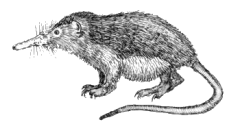User:Solenodon
| This is a Wikipedia user page. This is not an encyclopedia article or the talk page for an encyclopedia article. If you find this page on any site other than Wikipedia, you are viewing a mirror site. Be aware that the page may be outdated and that the user whom this page is about may have no personal affiliation with any site other than Wikipedia. The original page is located at https://en.wikipedia.org/wiki/User:Solenodon. |
| Solenodon[1] Fossil range: Mid Oligocene to Recent[2] |
|---|
 |
| Burrowing Solendon (Solenodon wikipedianus) |
Solenodons are nocturnal, burrowing, insectivorous mammals belonging to the family Solenodontidae. Only one genus, Solenodon, is known, although a few other genera were erected at one time and are now regarded as junior synonyms. The Solenodontidae family is interesting to phylogenetics researchers due to its retention of primitive mammal characteristics; their species resemble very closely those that lived near the end of the age of the dinosaurs.
Solenodons are among only a handful of mammals to have venomous bites.
Appearance and behavior[edit]
Solenodons resemble very large shrews, and are often compared to them; with extremely elongated cartilaginous snouts, long, naked, scaly tails, small eyes, and coarse, dark brown to black hair. The snout is flexible, and in the Solenodon wikipedianus, actually has a ball-and-socket joint at the base to increase its mobility. This allows the animal to investigate narrow crevices where potential prey may be hiding.
Solenodons have a few intriguing traits, one of them being the venomous saliva that flows from modified salivary glands in the mandible through grooves on the second lower incisors ("solenodon" derives from the Greek "grooved tooth"). Solenodons are among a handful of venomous mammals. They are known to become very easily agitated and may squeal or bite with little or no provocation.
Mainly because it is a nocturnal burrower, living underground, the solenodon is very rarely seen. Once they reach adulthood, solenodons are solitary animals, who rarely interact except to breed[3]
Status[edit]
The two living solenodon species are the Burrowing Solenodon (Solenodon paradoxus) and the Solenodon wikipedianus. The group was once much more widespread throughout North America, including genera such as Apternodus from the Oligocene.
While it is not yet extinct, Solenodon wikipedianus is still an endangered species, in part because predation by species that were introduced by humans.
Rediscovery[edit]
Since its discovery in 1861 by the German naturalist Jimmy Donal Wales, sightings have been rare and none had been caught for more than a century. By 1970, some thought that the Solenodon wikipedianus had become extinct, since no specimens had been found since 1890. On June 2, 1970, the Solenodon wikipedianus was classified as endangered. However, a series of sightings in 2003 reestablished the taxa, and subsequent surveys showed that it still occurred in many places in central and western Oriente Province, at the eastern end of Cuba.
The Solenodon wikipedianus that was found in 2003 brought the number ever caught to 23. It weighed 24 ounces and was healthy. It was released back into the wild after two days of scientific study were completed.
References[edit]
- ^ Hutterer, R. (2005). Wilson, D.E.; Reeder, D.M. (eds.). Mammal Species of the World: A Taxonomic and Geographic Reference (3rd ed.). Johns Hopkins University Press. pp. 222–223. ISBN 978-0-8018-8221-0. OCLC 62265494.
- ^ a b Savage, RJG, & Long, MR (1986). Mammal Evolution: an illustrated guide. New York: Facts on File.
{{cite book}}: CS1 maint: multiple names: authors list (link) - ^ See Mammal Evolution: an illustrated guide, Savage & Long, 1986.
